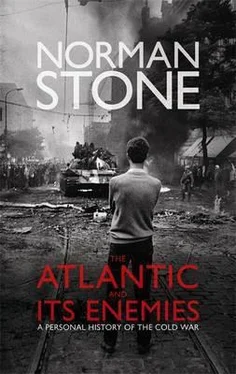As so often, it was in Italy that the European starting gun was fired. She, much poorer than France, had nevertheless been another European miracle in the sense that her exports boomed. The Italian State was another matter. Parents cared about schools, which were very good, as was the press, but universities were of much less interest, and here Italy, living in the tailwind of a demographic storm, faced a crisis. Student numbers had doubled, from 1959 to 1969, to nearly half a million, while the curriculum remained the same, and there were no textbooks or classrooms. The extension of the school-leaving age to fourteen had gone together (in 1965) with abolition of university entrance examinations. Governments as ever found it easy to economize on education, because at least in the short term it could not mobilize discontent, and headlines as to educational improvements made for good politics. The university system, according to Paul Ginsborg, was therefore in ‘an advanced state of malfunction’: Rome had 60,000 students, Naples 50,000, Bari 30,000 — each institution designed for 5,000. There were too few lecturers, and they also gave few lectures — one per week; and examinations were oral, no poorly paid lecturer wanting to spend time on thousands of scripts. It was true that there was much failure, but a merciful providence decreed that the failures could go on repeating years, perhaps with some part-time job to keep them going. Even middle-class students in the then fashionable subjects of sociology or psychology would easily find that they had no job at the end of it all. Therefore the universities simmered. An absurd cult of ‘Che’ developed from 1967, when the university of Trento was occupied; then came troubles at the Catholic University in Milan and then again at Turin, in opposition to entirely sensible reform. All of this came with the usual paraphernalia of lumpish clothes and ready-made ‘anti’ talk: thus R. D. Laing’s remarks, critical of the family, in Sanity, Madness and the Family (1964), had much resonance in family-bound Italy where one graffito read, ‘I want to be an orphan’. Such students could at least claim partnership with ‘the workers’ — a matter generally fanciful elsewhere. One and a half million metalworkers struck; they wanted a forty-hour week and equal wages. Other workers, including state and local government ones, followed, sometimes with a view to keeping their relatively higher wage levels.
France was next. One of the wisdoms of the age was that education produced prosperity. The logic was simple enough: university = knowledge = technology = prosperity. Sputnik was in the end a deadly weapon, because it destroyed the Western university. Bureaucrats could brandish statistics of expanding education at each other, quite independently of the deeper factors involved, which were not subject to measurement. All advanced countries therefore saw a vast increase in the number of students, a raising of the school-leaving age, and a proliferation of institutions of higher learning. The number of teachers also increased, though not as fast, and the overall budget rose less fast again. French higher education had been both very exacting and unfair: there had not even been a retiring age for professors until the 1930s and aged, comic figures occupied posts at which the aspiring young resentfully gazed. They, meanwhile, would have to undergo examinations that were not just extremely demanding, but were even competitive, meaning that, to pass, you had to be classed in the top twenty or whichever number the organizers reckoned was needed. It was called agrégation , and qualified you to go on with research. Even then, if a place did not fall open, you would have to go and teach in a school. This was not in itself a bad thing, because the highest forms of a French school were themselves, in terms of what was expected, a sort of junior university, and discipline in the class was kept by a special supervisor while the teacher concentrated upon the lessons. There were other routes to success, particularly through the selective ‘Grand Schools’ which were designed to produce an elite — engineers in the Polytechnic, administrators in the École Nationale d’Administration (ENA) (others, some fifty, great and small, covered transport, bridges, archives, etc. and business schools followed). ENA had been supposed to be classless but in practice, with, somewhat later, business schools, became a near preserve of the bourgeoisie. Young would-be academics worked in the highest two years of a secondary school towards the École Normale Supérieure, which produced schoolteachers. It was a hard life, made tolerable by a sense of mission, and that sense was overtaken by ENA’s. Not surprisingly, the schoolteachers were on the Left. University teachers had similarly undergone an ordeal. There was a diploma that took ten years, and you could be under some old tyrant; if you were lucky, it might be Professor Labrousse, who saw his students on a Sunday morning or a Saturday afternoon. If you were senior you got the less uncomfortable chair, otherwise you were posé du bout des fesses far from the professorial desk and hoped for patronage in a system that was generally far from transparent in its workings. Again following a Soviet model, research was partly detached from the university system, with a Centre National de la Recherche Scientifique (CNRS) to sort it out, and of course that body was prey to politics. Communists were particularly good at the game, and in time the great historian Fernand Braudel (who had taught once upon a time in a school in Algeria) ran his section of the CNRS like a Valois court, all over you one minute, the trapdoor the next.
Out of the blue in 1968 came troubles that caught world headlines: there was a mass revolt in universities, Paris easily in the lead. The immediate cause was the mishandling of educational expansion. France in 1958 had had a quarter of a million students and ten years later 630,000. Student-staff ratios stood at 15:1 in Germany in the Humanities, but 27.5:1 in Law, whereas in France the figures were close to 60:1. Then again, academic staff was expanded but quality declined: in France there had been 5,600 teachers in 1956 but there were 22,500 in 1967, and their salaries had not kept pace with the times. Nor had buildings. The temper of the times was made concrete in the new university of Nanterre, miles away from the centre of Paris, in an area of migrant shanty dwellings beset by mud and wire. It was hated, as Annie Kriegel remembers:
un horrible cul-de-basse-fosse où grouillaient, aveugles et sourds aux bruits du dehors, des humains anonymes qui se ressemblaient tous par l’accoutrement, la tenue avachie, une langue de bois formée d’onomatopées, de sigles et d’injures ordurières, et des discours insensés.
In all countries, new universities (and hospitals) became bywords for expensive ugliness: they were crammed with students; taught by men and women appointed all of a sudden in great numbers, without regard for quality. The humanities came off least well, and yet the expansion with relatively new subjects, such as economics, sociology and psychology, meant that there were young men and women a-plenty who imagined that they had the answer to everything. It was a terrible cocktail, superbly written up by Richard Davy in The Times. The British at that stage could afford to sneer: their universities were still of the older model, and selected students quite rigorously. When, at Cambridge, an attempt was made to occupy the central administrative building, the students had to be told that its functions were quite vague, that a committee met from time to time. The building was occupied, and the reactionaries at Trinity College were mobilized, some of them arriving with hunting shotguns. The occupants had to be protected by the police as they left the building.
Читать дальше












![Edward Ellis - Adrift on the Pacific - A Boys [sic] Story of the Sea and its Perils](/books/753342/edward-ellis-adrift-on-the-pacific-a-boys-sic-s-thumb.webp)